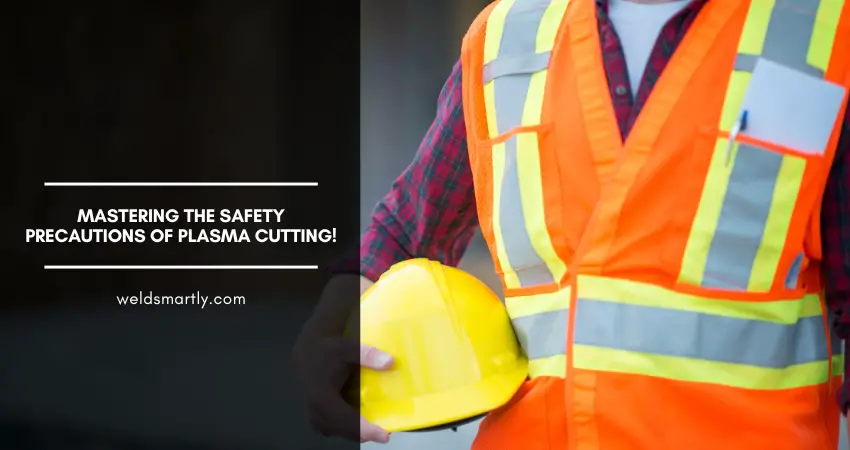A plasma cutter is a powerful tool used to cut metal by creating an intense beam of hot plasma. It is a versatile tool that can be used for various projects, from home repairs to industrial fabrication. However, it is important to note that plasma cutters can be dangerous if not used properly.
In this article, we will discuss the safety precautions that should be taken when using a plasma cutter.
Personal Protective Equipment (PPE)
Personal protective equipment (PPE) is essential when using a plasma cutter. The following items should be worn at all times:
- Welding helmet or goggles: These protect the eyes from the intense light and flying debris produced by the plasma cutter.
- Gloves: Welding gloves protect the hands from burns and cuts caused by the hot plasma.
- Long sleeves and pants: Long sleeves and pants protect the skin from burns and flying debris.
- Closed-toe shoes: Closed-toe shoes protect the feet from heavy objects and debris on the floor.
It is important to ensure that the PPE is properly fitted and maintained. This means that the helmet or goggles should fit snugly and not be too loose, and that the gloves should be free of holes or tears. Additionally, the PPE should be cleaned and stored properly when not in use.

Safety Features of the Plasma Cutter
Plasma cutters come with a variety of safety features that should be used and maintained properly. These include:
- On/off switch: This switch controls the power to the plasma cutter. It should always be turned off when the plasma cutter is not in use.
- Emergency stop button: This button can be used to quickly shut off the power in case of an emergency. It should be easily accessible and in good working condition.
- Air pressure and flow gauge: This gauge shows the air pressure and flow rate to the plasma cutter. The proper settings should be used and the gauge should be checked regularly to ensure that the air pressure and flow rate are correct.
Proper Setup and Use
Proper setup and use of a plasma cutter is essential for safe operation. The following steps should be taken:
- Ground the workpiece: The workpiece should be grounded to ensure that the electrical current flows through the metal and not through the operator. This can be done by attaching a ground clamp to the workpiece and connecting it to a ground source.
- Proper distance from the workpiece: The plasma cutter should be held at the correct distance from the workpiece to ensure that the cut is clean and accurate. This distance will vary depending on the thickness of the metal and the type of plasma cutter being used.
- Adjusting the air pressure and flow: The air pressure and flow rate should be set to the proper level for the type of metal being cut and the thickness of the metal.
When using the plasma cutter, the following steps should be taken:
- Hold the torch correctly: The torch should be held with a firm grip and in a comfortable position to avoid fatigue.
- Move the torch in the correct direction: The torch should be moved in a steady and controlled manner, following the line of the cut.
- Maintain a steady speed: The speed of the torch should be consistent to ensure a clean and accurate cut.
Warning signs of improper use include:
- Sparks or flames shooting out of the plasma cutter
- Uneven or rough edges on the cut
- Unusual noise coming from the plasma cutter
- Excessive smoke or fumes coming from the plasma cutter
Maintenance and Storage
Proper maintenance and storage of a plasma cutter is essential for safe operation. The following steps should be taken:
- Cleaning and lubricating the torch: The torch should be cleaned and lubricated regularly to ensure that it is in good working condition. This includes removing any debris or buildup and lubricating the moving parts.
- Checking for worn or damaged parts: The plasma cutter should be inspected regularly for worn or damaged parts, such as the electrode or nozzle. These parts should be replaced as needed to ensure that the plasma cutter is in good working condition.
Proper storage of the plasma cutter includes:
- Storing the plasma cutter in a dry, cool place: The plasma cutter should be stored in a place that is free from moisture and extreme temperatures to prevent rust and damage.
- Keeping the plasma cutter away from flammable materials: The plasma cutter should be kept away from flammable materials to prevent fires.
Conclusion
In conclusion, it is important to take safety precautions when using a plasma cutter. This includes wearing the appropriate personal protective equipment, properly using and maintaining the safety features of the plasma cutter, setting up and using the plasma cutter correctly, and properly maintaining and storing the plasma cutter. Following these precautions will help ensure that the plasma cutter is used safely and effectively.
References:
- Safety Precautions for Plasma Cutting. (n.d.). Retrieved from https://www.millerwelds.com/resources/article-library/safety-precautions-for-plasma-cutting
- Plasma Cutting Safety Tips. (n.d.). Retrieved from https://www.hobartwelders.com/weldtalk/topic/14861-plasma-cutting-safety-tips
- Plasma Cutting Safety. (n.d.). Retrieved from https://www.lincolnelectric.com/en-us/support/welding-safety/Pages/plasma-cutting-safety.aspx
